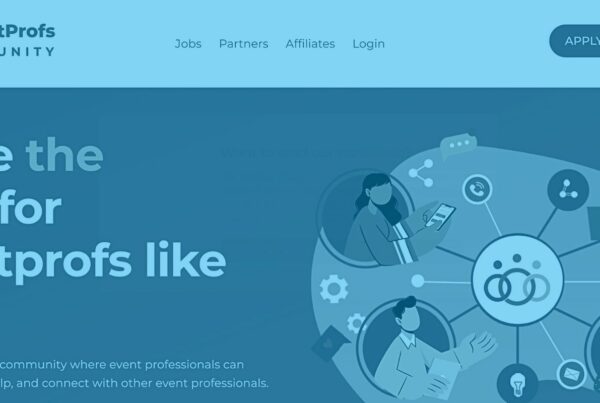One of the hottest topics in the events industry nowadays is hybrid and virtual audience engagement. But as the Event Tech Podcast highlights today, you can’t really talk about audience engagement without including audience response systems in the conversations. After all, the best way to learn what makes our beloved attendees tick is to simply ask them. Right?
In this episode, Brandt welcomes back Kyle Kocinski, the Head Of Implementation at Endless Events, to fill Will’s shoes. Some of you might know him already as he joined the show in the past when the tech nerds talked about virtual and hybrid event platforms. Today, they talk about the history of audience response systems, comment on the current state of audience engagement tools, and recommend some of their favorite tools to our listeners.
Audience Response Systems Are Not New
“As people are doing virtual and hybrid events, we talk a lot about how do we keep audiences engaged,” says Brandt to introduce today’s topic. “A lot of it is wrapped up in getting feedback from our audiences. This is something that is not new. One of the best ways to get people squiggling in their chairs and pay attention again is to ask them a question. For years, we’ve been dealing with audience response systems one way or another: polling systems, Q&A, and now, we have the real-time chat.”
The History of Audience Response Systems
Since Brandt’s been working in the events industry for much longer than Kyle, he starts today’s Event Tech Podcast episode with a little bit of history. “The original audience response systems were quite literally button boxes. They looked like remote controls from the 1950s where they had four physical buttons on them and you handed them out to everyone at the conference. Then, your presenters would ask questions. And there were very weird plugins for PowerPoint where you could bring up the polling and embed them in your PowerPoints.”
“These hardware boxes were a bit of a struggle, but they were pretty much bulletproof because it was radio-frequency. As long as you were within transmission range, they would register the votes. And what was really good about them is it was an effective way to make sure every vote registered. You would know whose vote was whose in the backend. It looked like garbage, but it was actually a pretty extensive ecosystem of how you could tabulate these responses. That’s what we had for decades.”
Then, the events industry started to work its way into event apps, which is where Kyle picks up the conversation. “That’s why I think this topic is so relevant today. We saw a boom of event apps and platforms over the past few years. Now, it’s time to take a look back and see where did audience response technology go during this time. What are some ways that you can amplify or enhance some of those ways you were already asking questions or looking for participation? There are a lot of exciting trends we’re seeing out there, but you’re going to see the same type of technology: hardware-based solutions.”
 Audience Response Systems: Where Do We Stand Today?
Audience Response Systems: Where Do We Stand Today?
“Where we’re at with that right now is still kind of trying to get to where we were with the hardware solutions,” says Brandt. “By the end there, we had a pretty magical device.” He’s talking about a device that highly resembled the then-popular Blackberry phone. “We could type our responses in, we could do polling. There was also a microphone that you could respond into. They’ve tried to replicate these systems on our phones and on the web, but none of them have really gotten back to the point of being able to do all of that. For example, Crowd Mics tried to do the ‘speak-into-your-cell-phone-as-a-microphone’ thing. And it just never really worked because it’s trying to use technology that was never meant to do real-time audio, going off to space, then bouncing back, and then going through a sound system without having any latency.”
“When we’re looking at what makes up an audience response system today, it needs to be first and foremost easy to join,” says Kyle. “A lot of tools you’ll see will scan your device with a QR code or just put in a four-digit code, and use a really quick and short link to get there. Also, being device friendly. Regardless of the device you’re using, being able to answer at the same rate.”
Data Visualization & Personalization
Another current trend that Kylie mentions is data visualization. “One of the key differentiators between a lot of the audience response systems and tools is when you’ve answered the question or you’ve shared your opinion, how is that represented to everybody? Is that information private and is it used later on throughout your event experience?”
“If you’re asking questions through your audience response system, then you can start to do a lot with personalization,” adds Brandt. “You respond to what’s your native language, for example. And then, when you walk up to registration that day, it says ‘Welcome Brandt’ in your native language. So you can use these types of systems as onsite surveying systems to gain that real-time access to real-time information. What are you liking? What sessions are you most likely to attend? If you don’t require pre-registration for the breakouts, then you can start to actually gauge in real time how many people are going to go to each session and maybe even change things around.”
How Much Event Technology Is Too Much?
All these event tech trends might sound exciting to technology enthusiasts, but what about your average attendee? Kyle asks Brandt the question that they often tackle on this podcast: how much event technology is too much? The last thing event planners want is their attendees getting lost.
“That is the money question,” says Brandt and chuckles. “The refrain that I am just saying as often as possible these days is that you can’t buy engagement and interactivity. It’s much more important to think about the design of your event. And then go look for tools and technology that are going to help you achieve those goals and objectives. People have a tendency to want to throw technology at a problem, as opposed to designing their way and looking for the right technology to solve it.”
“You can have the coolest audience response system, but then only one presenter would use it for one question in one session. And so when you talk about what’s too much technology, there are two different questions in there. One is having too much technology that you’re not using. And then another where there’s too much technology for the attendee,” he explains.
Audience Response Systems Made Easy By Emcees
In his opinion, emcees have the power to make event technology manageable for the audience. If they hold people’s hands through the process of accessing the event app and using it, audiences might not be overwhelmed. “But if you just tell them to click on the app and start explaining this big, complicated process to try and get into the engagement side, people will feel like that’s too much technology.”
Kyle shares some invaluable advice to all the event planners listening out there. “If you want to integrate an audience response system and use it through your event process, provide training to your speakers much further in advance.” Speaker training is one of the biggest event trends of the year and its importance simply cannot be overstated. “Explain what tool you’re going to use, why you’re using it and tell them why it’s good for them to use it. If you have an implementation team that can help support your speakers, that takes the stress off of them having to completely learn something new,” he elaborates.
Audience Response Systems: Where Do They Go Next?
Kyle and Brandt move from the present into the future. “We’re still struggling to get back to where we were, when all of this just worked with hardware. It feels like a lot of the tools have two out of three things. It’ll have the chat and the Q&A, but it won’t have polling. Or it’ll have polling and Q&A, but it won’t have chat. Even Zoom disables the Q&A or the chat, depending on whether you’re using meeting or webinar. You can’t have Q&A in a meeting and you can’t have chat in a webinar,” says Brandt.
“We’re slowly going to continue to piece these things together. Some of it will be built into the technology and some of it will remain third-party that you can bolt on. And I’ve got a certain affinity for third parties that just integrate with everybody. I was looking at a product that is basically integrated chat that can be embedded into any platform: your conference webpage, your event platform, and your event app. And it’s all the same chat, the same connections. The innovations will be taking advantage of cloud computing and databases,” he says.
Audience Response Systems Fostering Connections
Kyle shares his hopes for the future of audience response systems. “I know that the privacy is the biggest challenge here, but I would love for the app or the platform to recommend me other like-minded people in the room who agreed with me. Then after the session, I can go and touch upon my ideas with them in a little bit more detail. Right now, I’m really only able to see the general consensus of the room. Whereas I’d love to connect with other like-minded or opposing-minded people after.”
“If we can include some sort of currency into the event, whether that is a cryptocurrency or an event coin, it gives the attendees more ways to interact within the session,” he adds. “Maybe that’s turning on the lights to be a different color in the room because they really loved what that speaker said. I think there are a lot of ways we can integrate technology and audience response systems with the venue.”
Lastly, Recommendations!
After covering the past, present, and the future of audience reponse tools, Brandt and Kyle share their favorite products. “I have recently rediscovered Slido. I’m a pretty big fan of how easy that is to use. Poll Everywhere is still a bit of a gold standard when it comes to needing to have as many different ways as possible for people to access it. Another one is Hio Hovr. I just got a demo a week or so ago. They are doing the integrated chat for events,” says Brandt.
Kyle’s Favorite: Sparkup, Duelbox, & Piccles
Kyle goes next. “If you’re looking to bring your virtual audience onstage, there are two amazing tools that are really innovative right now. The first one is Sparkup. The other one started out at sports games and it’s called 15 Seconds of Fame. It’s when your picture gets blown up on the jumbotron. Imagine a picture of yourself, attending a keynote and there you are. Well, those 15 seconds of your fame can be saved and you can share that on social media.”
“Another tool that was really fascinating to me at Event Tech Live was Duelbox: it’s just an audience response system that you can integrate with multiple operators throughout your venue. Regardless of what activities and responses you’re taking part in as an attendee, they’re all carried with you to whatever room or session you go to.”
“Lastly, I’ll conclude with Piccles, a tool that incorporates drawing. If you’re looking to do drawing-based challenges, take a look at it and see how your attendees can draw on their own device and share their responses that way.”
Conclusive Thoughts
Kyle just has one more encouraging thing to add before they wrap the episode up. “”What’s great about all of these tools is regardless of your budget, there’s something for you and your event. It could start as low as a $100/month to bring in a tool like this, but it could also boom up to $100,000 for just one event. As you’re planning your in-person and hybrid strategies, think about how you can bring these tools into those experiences.”
And in case you’re not sure you can do it all alone, fret not! If you’ve got any questions, talk to us! The Endless team is here to help and hold your hand through the event-planning process.











